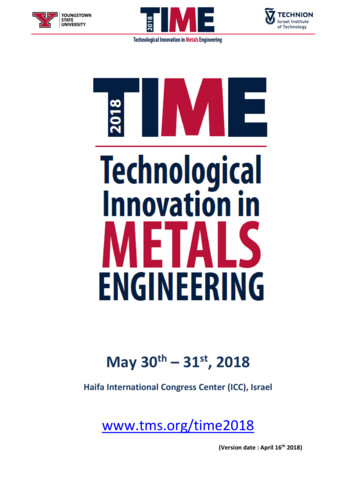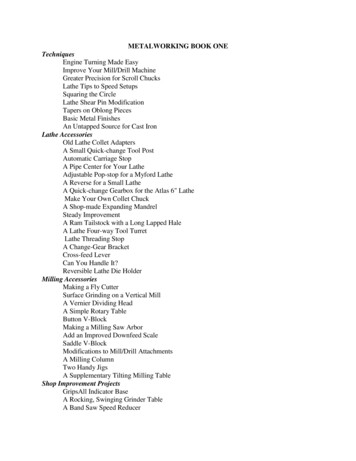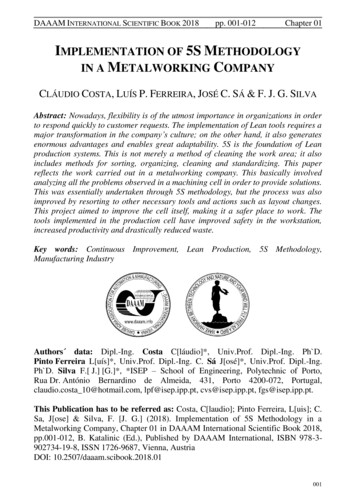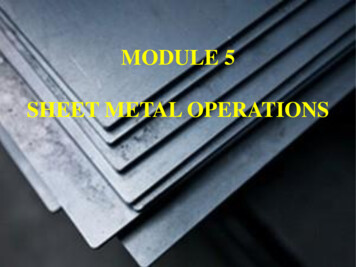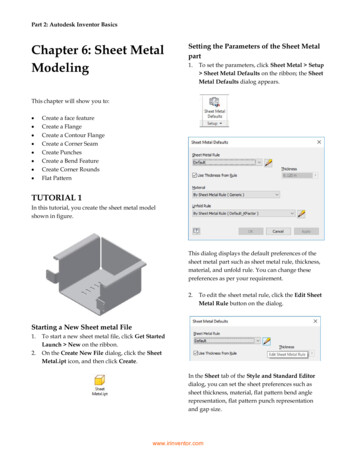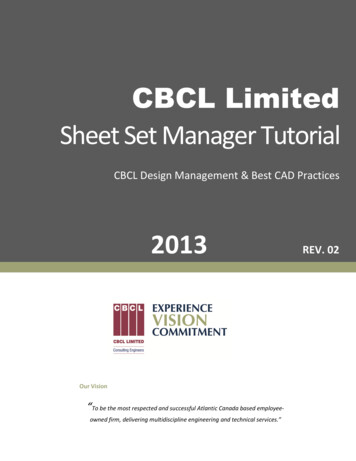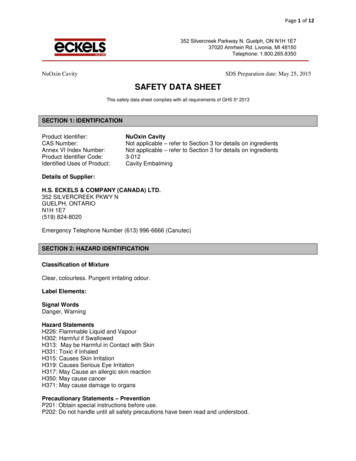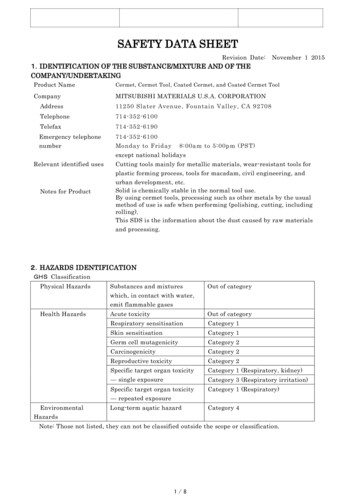
Transcription
SAFETY DATA SHEETRevision Date:1.IDENTIFICATION OF THE SUBSTANCE/MIXTURE AND OF THECOMPANY/UNDERTAKINGNovember 1 2015Product NameCermet, Cermet Tool, Coated Cermet, and Coated Cermet ToolCompanyMITSUBISHI MATERIALS U.S.A. CORPORATIONAddress11250 Slater Avenue, Fountain Valley, CA ency telephone714-352-6100numberMonday to Friday8:00am to 5:00pm (PST)except national holidaysRelevant identified usesCutting tools mainly for metallic materials, wear-resistant tools forplastic forming process, tools for macadam, civil engineering, andNotes for Producturban development, etc.Solid is chemically stable in the normal tool use.By using cermet tools, processing such as other metals by the usualmethod of use is safe when performing (polishing, cutting, includingrolling).This SDS is the information about the dust caused by raw materialsand processing.2.HAZARDS IDENTIFICATIONGHS ClassificationPhysical HazardsSubstances and mixturesOut of categorywhich, in contact with water,emit flammable gasesHealth HazardsAcute toxicityOut of categoryRespiratory sensitisationCategory 1Skin sensitisationCategory 1Germ cell mutagenicityCategory 2CarcinogenicityCategory 2Reproductive toxicityCategory 2Specific target organ toxicityCategory 1 (Respiratory, kidney)— single exposureCategory 3 (Respiratory irritation)Specific target organ toxicityCategory 1 (Respiratory)— repeated exposureEnvironmentalLong-term aqatic hazardCategory 4HazardsNote: Those not listed, they can not be classified outside the scope or classification.1/8
GHS Label ElementDusts resulting from the raw material and processingAlloys and ProductPictgram(s)Not applicableSignal Word(s)Not applicableDangerMay cause allergy or asthma symptoms or breathingHazarddifficulties if inhaled.Statement(s)May cause an allergic skin reaction.Suspected of causing genetic defects.Suspected of causing cancer.Suspected of damaging fertility or the unborn child.Causes damage to organs (respiratory, kidney).May cause respiratory irritationCauses damage to organs (respiratory).Precautionary Statement(s)Obtain special instructions before use.【Prevention】Do not handle until all safety precautions havebeen read and understood.Do not breathe dust/fume/ gas/mist/vapours/spray.Avoid breathing dust/fume/gas/mist/vapours/spray.Wash hands thoroughly after handling.Do not eat, drink or smoke when using thisproduct.Use only outdoors or in a well-ventilated area.Contaminated work clothing should not be allowedout of the workplace.Wear protective gloves/ protective clothing/eyeprotection/face protection.Wear respiratory protection.Call a POISON CENTER or doctor/physician if you【Response】feel unwell.IF ON SKIN: Wash with plenty of soap and water.IF ON SKIN: Gently wash with plenty of soap andwater.If skin irritation or rash occurs: Get medicaladvice/attention.IF INHALED: Remove victim to fresh air and keep atrest in a position comfortable for breathing.IF exposed or concerned: get medical advice/attention.If exposed or concerned: call Poison Center/ doctor.Take off contaminated closes and wash it beforereuse.If experiencing respiratory symptoms: Call aPOISON CENTRE or doctor/ physician.Store locked up.【Storage】Store in a well-ventilated place. Keep containertightly closed.The contents and containers, to entrust the work to a【Disposal】professional waste treatment company that hasreceived the permission of the prefectural governor.2/8Not applicable【Prevention】Obtain specialinstructions beforeuse.Do not handle untilall safetyprecautions havebeen read andunderstood.
3.COMPOSITION/INFORMATION ON INGREDIENTSSubstance or MixtureMixtureCermet in some cases it is coated with the following materials.AlN, Al2O3, (Al,Ti)N, B4C, Cr3C2, CrN, MoS2, Ti(B,C,N), TiC, (Ti,Zr)N, WC, C(Diamond, DLC)Chemical names and Contents of the cermetChemical formulaCAS No.Content(%)Titanium CarbideTiC12070-08-515-50Titanium nitrideTiN25583-20-40-30Tungsten CarbideWC12070-12-10-30Tantalum CarbideTaC12070-06-30-20Niobium CarbideNbC12069-94-20-20Mo 2 C12069-89-50-20Zirconium Ni7440-02-00-20Chemical NameMolybdenum Carbide4.FIRST AID MEASURESInhalationIf symptoms of pulmonary involvement develop (coughing, wheezing,shortness of breath, etc.), remove from exposure and move fromworkplace to isolate.If breathing difficulties occur, making the oxygen inhalation. Ifbreathing has stopped, immediately perform artificial respiration andseek medical advice/attention.Skin contactIf when the dust adheres to the skin, remove clothing dust adheredand thoroughly wash the attached area with soap and water.If irritation or rash persists, seek medical advice/attention.Eye contactIf dust gets into eyes, flush with copious amounts of water. Ifirritation persists, seek medical advice/attention.IngestionIf substantial quantities of dust are swallowed, dilute with a largeamount of water and seek medical advice/attention.5.FIRE-FIGHTING MEASURESExtinguishing mediaIn the case of dust fire, dry sand,extinguish with expandedSuitable Extinguishing Mediavermiculite, expanded perlite, ABC type (general, oil, electric fire)powder extinguishers, or water (the dust containing chips of lightmetal such as magnesium or aluminum etc. is banned toextinguish with water).Special hazards arising fromUnder certain conditions, dust such as the particle size isthe substance or mixtureextremely fine and mixed with the grinding oil with low flashpoint, there is a possibility of spontaneous combustion. In the casewhere dusts under very flammable conditions are dispersed intothe atmosphere, which may fall within the explosive limits. Insuch cases, first after secure the safety of themselves, takenecessary fire-fighting measures.Advice for fire-fightersFire fighters should use a suitable mask with filter or respiratoryprotection.3/8
6.ACCIDENTAL RELEASE MEASURESPersonal precautions,Person cleaning the dust wears equipment with respirator etc. andprotective equipment andclothes to minimize the exposure to the human body.emergency proceduresEnvironmental precautionsTreat dust as industrial waste and avoid release to the waterenvironment.Methods and material forFor dusts, isolate the location and remove using a vacuum cleanercontainment and cleaning upwith filters that can be recovered fine particles with highefficiency.If there is no suitable removal method, remove the dust with watersprayers or wet mops.7.HANDLING AND STORAGEPrecautions for safe handlingAlthough Cermet is stable substance and has little effect onhealth, may cause rough skin for a long time or repeated contact tothe dust or grinding liquid containing cobalt or nickel.Since the Cermet has a high specific gravity, treat as heavy goodsif large product or quantity is large.If the scattering of dust containing cobalt or nickel is conceivable,use installation such as local exhaust ventilation and protectiveequipment to minimize the exposure of the human body.Wash hands thoroughly before eat and drink.Do not eat, drink or smoke when using this product.Periodic medical examinations are recommended for individualsCondition of safe storageregularly exposed to dust or mist.Stored to avoid sudden changes of temperature and highhumidity.8.EXPOSURE CONTROLS/PERSONAL PROTECTIONAppropriate engineering controlsThe installation of local exhaust ventilation, airborne dust will not exceed the reference value ofthe allowable concentrations listed in the following table.Placing the cleansing device or safety shower in workplace storage or handling this material.Furthermore, also be placed dressing equipment and facilities for washing.Occupational Exposure Limits (reference value)Chemical NameChemicalOSHA PEL (mg/m 3 )ACGIH TLV (mg/m 3 )formula(Concentration of Metal Dust)(Concentration of Metal Dust)Titanium CarbideTiCN/AN/ATitanium NitrateTiNN/AN/ATungsten CarbideWCN/A5 (as W)Tantalum CarbideTaCN/AN/ANiobium CarbideNbCN/AN/AMo 2 C1510(as Mo)Zirconium CarbideZrC55CobaltCo0.10.02Molybdenum CarbideNickelNi1.0Note: OSHA: Occupational Safety & Health Administration U.S. Department4/81.5
PEL: Permissible Exposure LimitACGIH: American Conference of Governmental Industrial Hygienists Inc.TLV: Threshold Limit ValueN/A: Not ApplicablePersonal protection equipmentRespiratory protectionWear a dust mask and respiratory protection against dust.Hand protectionWear protective gloves against dust.Eye/face protectionWear protective glasses against dust.Skin protection (Body /Direct contact should be avoided with the skin.Other)Clothes, rags or other items, to remove attached dust, be sureto remove by washing or vacuuming using the appropriatefilter without shaking off.Contaminated work clothing should be changed by new one。9.PHYSICAL AND CHEMICAL PROPERTIESAppearanceDark Grey MetalOdorpH (Value)OdorlessMelting pointNo data availableBoiling pointNo data availableFlash pointNo data availableSpecific Gravity (H20 1)6.0 to 9.0Solubility in Water:InsolubleNo data available10.STABILITY AND REACTIVITYReactivityContact of dust with chemicals such as acidmay causeharmful gas generation .Chemical stabilityThe product is a solid state and is not explosive, flammable,combustible, pyrophoric and oxidizing. Under normalcircumstances the product is chemically stable.Possibility of hazardous reactionsIn powder or granular form, there is a possibility of dustexplosion mixed with air.Conditions to avoidAviod to contact with [Incompatible materials]Incompatible materialsOxidizing substance (such as hydrogen peroxide, nitric acid,ammonium nitrate, nitrogen dioxide etc.)Other substances (Hydrazine nitrate, acetylene, etc.)Hazardous decompositionNoneproduct(s)11.TOXICOLOGICAL INFORMATIONAcute toxicityNo data availableSkin corrosion / irritationNo data availableSerious eye damage/irritationNo data availableRespiratory or skinCobalt and Nickel classified into Category 1 for respiratorysensitizationsensitizer by Japan Society For Occupational Health (JSOH).Cobalt and Nickel classified into Category 1 for skin sensitizerby Japan Society For Occupational Health (JSOH).Germ cell mutagenicityNo data availableCarcinogenicityCobalt and Nickel are carcinogen classified IARC 2B.IARC 2B: Probably carcinogenic to humans5/8
Reproductive toxicityThere is a report of Cobalt that when rats were exposed to thesubstance in drinking water for 7 months before pregnancyand during pregnancy, a slight increase in pre-implantationmortality was found and some cases of malformed fetuses werenoted (Teratogenic (12th, 2007)).STOT - single exposureBased on the data, Nickel was classified into Category 1(respiratory system, kidney).STOT - repeated exposureBased on the data, Nickel was classified into Category 1(respiratory system).Aspiration hazardNo data availableOther informationNo data availableNote: STOT: Specific target organ toxicity12.ECOLOGICAL INFORMATIONPersistence and degradabilityAlthough there is mobility in the floating dust, it is easy todeposition for specific gravity is large.No information of CermetBioaccumulative potentialNo information of CermetEnvironmental effectsNickel was classified into Category 4 since it is a metal andMobilityits behavior in water is unknown though the data (L(E)C50 100 mg/L) are available.13.DISPOSAL CONSIDERATIONSDisposal methodsMain component(tungsten carbide, cobalt or nickel)is a raremetal, harvested, it is desirable to recover and recycle.Dispose of waste in accordance with appropriate Federal,State, and Local government environmental regulations.14.TRANSPORT INFORMATIONUN numberUN proper shipping nameTransport hazard class(es)Marine pollutantNot applicableNot applicableNot applicableNot applicable15.REGULATORY INFORMATIONLows(Acts) and Regulations on chemical substances in U.S.A.Note: This product is regarded as the article and this product is physically and chemically stableunder normal conditions of tool use. Regulatory information described here is theinformation about the dust caused by raw materials and processing.TSCA InventoryAll substances are listed in TSCA Inventory.(All substances are listed in the table of ‘3.Conposition/Information onIngredients’.)TSCA SNUR ListAll substances are not listed in TSCA SNUR List.EPCRA/SARANickel is listed in EPCRA/SARA Section 302 Extremely HazardousSubstances.NTP Roc ListNickel is listed in NTP Report of Carcinogens (RoC) List.California Proposition 65Cobalt and Nickel are listed in California State Proposition 65 List.Cobalt has been found to cause cancer, which would require awarning under the statute by the State of California.6/8
Nickel has been found to cause cancer, birth defects or otherreproductive harm, which would require a warning under the statuteNoteby the State of California.TSCA: Toxic Substances Control ActSNUR: Significant New Use Rule under TSCAEPCRA: Emergency Planning and Community Right-to-Know ActSARA: Superfund Amendments and Reauthorization ActNTP: National Toxicology Program16.OTHER INFORMATIONOther hazardousinformationSee "Safety brochure" in the handling.Note the following about the dust.Dusts irritate to nose, mouth, throat, mucosa of eyes and also irritate the respiratory organs andlungs. The symptoms are allergic skin rash, in the respiratory system a cough, asthma, shortnessof breath, chest pressure and tightness in the chest.If you swallowed a large amount of dust containing cobalt, , there is a possibility that cause blood,heart, thyroid gland and spleen disorders.It has been reported that repeated or prolonged contact with cobalt and nickel may affect skin,respiratory organs and heart etc.Metal component (Carcinogenicity) has the following findings.Cobalt metal:Nickel metal:ACGIHA3: Confirmed animal carcinogen with unknown relevance to humansIARC2B: Probably carcinogenic to humansACGIHIARCA5: Not suspected as a human carcinogen2B: Probably carcinogenic to humansACGIH: American Conference of Governmental Industrial Hygienists Inc.IARC: International Agency for Research on CancerMetal component (Environmental effects) has the following findings.Cobalt may be harmful to the environment. Particular attention to the impact on aquaticorganisms it is necessary.Reference URLMinistry of Economy, Trade and Industry:http://www.meti.go.jp/Ministry of the Environment(PRTR):http://www.env.go.jp/Ministry of Health, Labour and Welfare(ISHL): http://www.mhlw.go.jp/IARC(The International Agency for Research on Cancer ): http://monographs.iarc.fr/ICSC card: http://www.nihs.go.jp/ICSC/The National Institute of Technology and Evaluation: 1)Food & Drug Research Laboratories, study No.8005B (4.11.84).(2)T. Shirakawa et al., Chest. 95, 29 (1989).(3)International Chemical Safety Cards (cobalt, chromium, nickel).(4) Hazardous and toxicity Handbook of chemical substances (Japan Industrial Safety&HealthAssocaition)(5)A. O. Bech et al., Brit. J. Ind., 19, 239 (1962).(6)IARC Monographs on the Evaluation of Carcinogenic Risks to Humans, vol.86 (2006).(7)NITE(National Institute of Technology and Evaluation, Japan), GHS classification resultshttp://www.safe.nite.go.jp/english/ghs/ghs index.htmlThe information contained in this Safety Data Sheet is provided in good faith and is believed to becorrect at the date of issue. However, it is expected that individuals receiving the information will7/8
exercise their independent judgement in determining its appropriateness for a particular purpose.The information given is designed only as a guide for safe handling, use, processing, storage,transportation, disposal and release and is not to be considered a warranty or quality specification.8/8
COMPANY/UNDERTAKING . Product Name . Cermet, Cermet Tool, Coated Cermet, and Coated Cermet Tool. Company MITSUBISHI MATERIALS U.S.A. CORPORATION Address 1125 0 Slater Avenue, Fountain Valley, CA 92708 Telephone 714 -352 -6100 Telefax 714 -352 -6190 Emergency telephone number 714 -352 -6100 Monday to Friday 8:00am to 5:00pm (PST)
